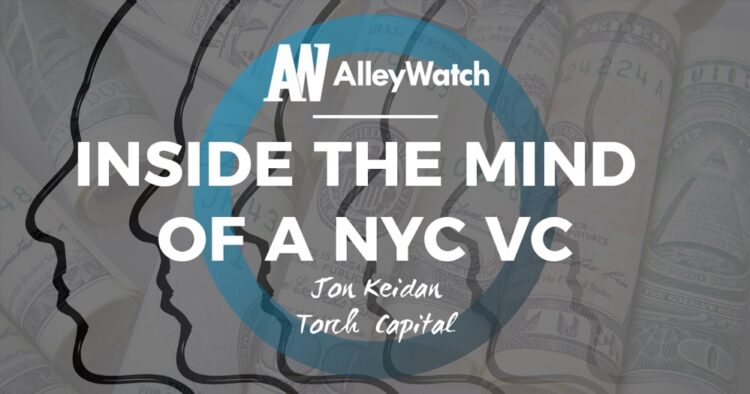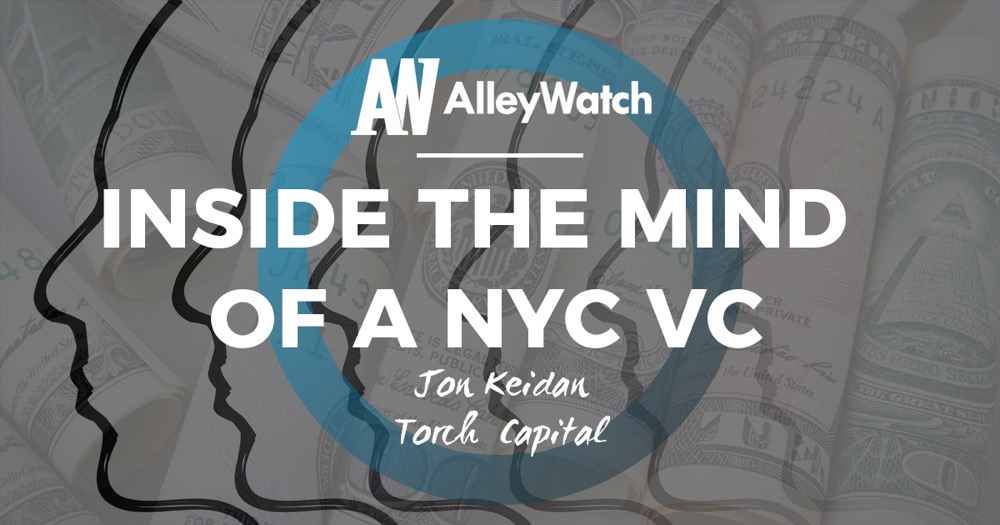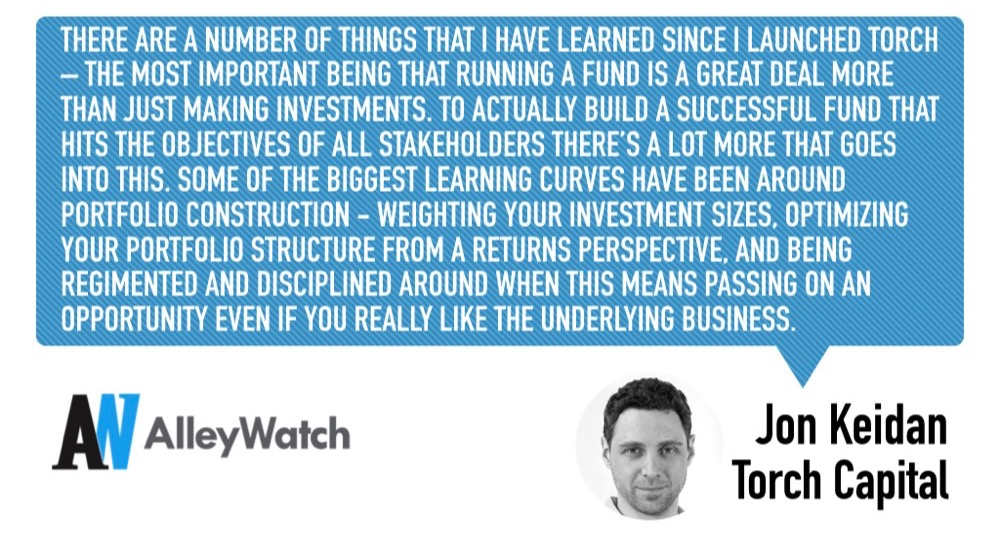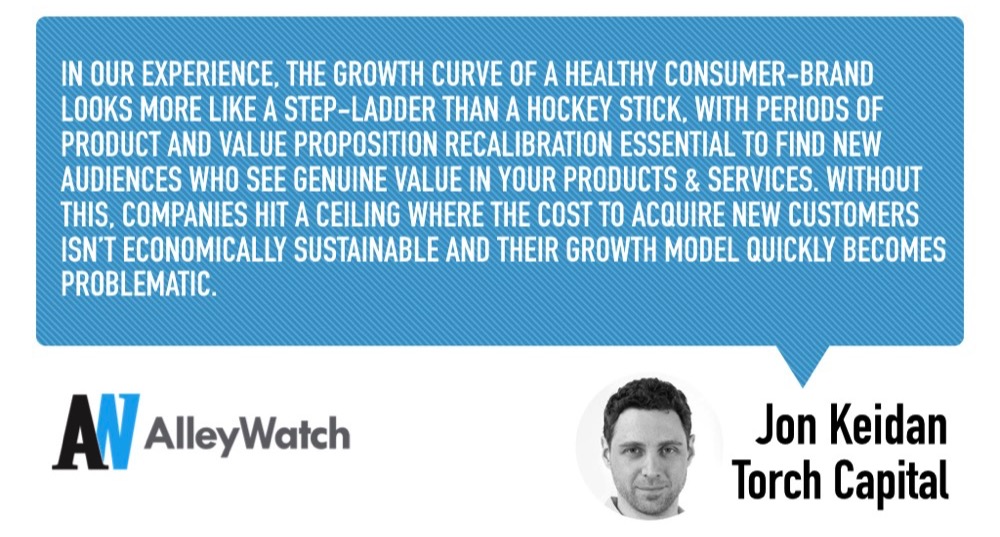Welcome back to Inside the Mind of an NYC VC, a highly acclaimed series at AlleyWatch in which we speak with leading New York City-based Venture Capitalists. In the hot seat this time is Jon Keidan, Founder and Managing Partner at Torch Capital, the early-stage consumer-focused venture firm, investing out of its inaugural $60M fund that closed earlier this year. Jon is a seasoned entertainment executive turned operator (he cofounded Inside Hook in 2011) who launched Torch to institutionalize his investment activity while as an angel. The firm counts some of the leading minds in the consumer space as well as prominent NYC operators as limited partners. The portfolio that Keidan has built is equally impressive and includes names like Ro, Sweetgreen, Zocdoc, Acorns, and Sir Kensington’s (acquired).
Jon was kind enough to join us in our offices in Soho to provide some candid insight into his path to tech and venture from the entertainment industry, trends in the consumer landscape and consumer behavior, actionable insights for any founder building a consumer-focused startup, and much, much more…
If you are a NYC-based VC interested in participating in this series, please send us an email. We’d love to chat. If you are interested in sponsoring this series that showcases the leading minds in venture in NYC, we’d also love to chat. Send us a note.
Reza Chowdhury, AlleyWatch: Please tell us a little bit about background and how you got to where you are today.
Jon Keidan, Torch Capital: I’ve actually always been an entrepreneur. I started my career in the entertainment industry, founding and running a management company, which I started after college, working with artists like John Legend, Dave Matthews Band, and The Nappy Roots. For 10 years, my career was all about spotting talent early, nurturing the careers of artists, helping them find their voice and reach their audience.
Deep in the business, I saw what was unfolding with the advent of digital disruption and how the whole media world was about to be completely transformed. With that backdrop, I left the music industry to pursue an MBA at Columbia Business School, followed by three years at McKinsey in their Entertainment, Media & Technology practice, where I got to see first-hand how the entire ecosystem was changing and evolving from the top down.
I left McKinsey to work with Jack Welch helping him launch his online education venture, The Jack Welch Management Institute – an invaluable experience learning how to operate and scale from idea through to execution. Pursuing my interest in EdTech, I then joined one of the UK’s fastest-growing edtech start-ups, Mendeley, to lead their US operations until the company was acquired by Elsevier.
I was then ready to start another venture, taking my learnings around content, media, and platforms to launch a men’s digital media publisher called InsideHook. We managed to build an extremely targeted and deeply engaged audience base, becoming a strategic marketing channel for not only the big liquor, watch and car companies, but also emerging digitally-native brands trying to reach our audience such as Harry’s, Everlane, Dollar Shave Club, Warby Parker, and Trunk Club.
Through working closely on marketing and content partnerships with these fast-growing brands, I watched the evolution of the online consumer ecosystem. I learned the inner workings of how these companies were building their brands, engaging their audience and scaling to become household names, and realized I had a unique perspective on understanding how consumer companies were growing their audiences and scaling their businesses.
Simultaneously, I started to see a number of friends and acquaintances launching companies as the New York tech scene began to make a comeback in 2012. I took what I had earned in the music business and began seeding entrepreneurs in New York and LA where I had a strong existing network – seeking out talented founders tackling real pain points in large markets.
My first three investments were seeding Compass, Zocdoc & Sir Kensington’s and subsequently investing in companies like Acorns, SweetGreen, BounceExchange and a string of other high-profile consumer brands. I built a portfolio of over 25 consumer companies, and as these companies began to grow, I stayed closely involved, realizing my past experiences enabled me to be very helpful and supportive to companies in this early stage. With this back-drop, I founded Torch Capital as the platform from which to formally institutionalize what I had been doing personally up to this point.
 What are the parallels between the music business and venture investing?
What are the parallels between the music business and venture investing?
There are a number of parallels between the music business and venture. In both, you are making a lot of risky bets and relying on a few outliers to outperform and make up for the bets that failed. That said, there are far more similarities to the specific role of being a manager in the music industry where you are a partner, a mentor, a teacher, a fixer, a confidence builder. Your role involves identifying talent, understanding their market, building their audience, helping them grow their brand, and giving them guidance, advice, and insight along the way.
The similarities to venture are obvious, where the talent are founders instead of musicians. These founders have a vision, they need to connect with their market, and find ways to engage their audience/ customers, requiring guidance and advice along the way.
What’s the transition been like from being an operator to being an investor?
I love being an investor – it’s an incredible job where you can wake up every day, engage with remarkable founders with groundbreaking ideas, and use your analytical side to figure out which companies you want to partner with and how you’re going to help bring their ideas to life. That said, there’s a huge part of me that still loves operating and I really take that focus, passion and energy and channel that into the way I operate Torch Capital.
We run the fund as a startup business – with our own rigorous internal processes, systems and strategies in place. A lot of the questions around scaling and operating that we ask our entrepreneurs, we asked ourselves, and set about building Torch with that same backdrop in mind, which allows me to still have my operating hat when operating as an investor.
As a first-time fund manager, what have you learned since launching?
Having been part of the founding management team of a number of companies, along with my experience investing in start-ups for almost 10 years, I was able to enter this role with eyes wide open.
I was also fortunate enough to have some incredible founders and terrific investors, who I had collaborated with previously, provide me with advice and guidance that has shaped how I operate.
That said, as with any new challenge, there are a number of things that I have learned since I launched Torch – the most important being that running a fund is a great deal more than just making investments. To actually build a successful fund that hits the objectives of all stakeholders there’s a lot more that goes into this. Some of the biggest learning curves have been around portfolio construction – weighting your investment sizes, optimizing your portfolio structure from a returns perspective, and being regimented and disciplined around when this means passing on an opportunity even if you really like the underlying business.
Time management has also been a constant balancing act – optimizing between sourcing new deals, analyzing opportunities and spending time with portfolio companies.
I believe for us, the most critical part of building the Torch brand has and will continue to be doing the work to be valuable to the growth of our portfolio companies – rolling up our sleeves with our entrepreneurs and truly helping them is key. Our founders are our best marketers and outperforming their own expectations of us is critical in building and maintaining our reputation in the space.
Is there a specific investment thesis that Torch Capital deploys? Where is the firm’s sweet spot?
Torch Capital is an early-stage fund. We primarily invest in Seed and Series A rounds with check sizes ranging from $500K-$3M. We predominantly focus on NYC and LA, but will look at anything in between the coasts.
We really think about investing through the following lens:
- Is what the company solving for a severe enough pain point?
- If the entrepreneur is successful in addressing this, is the market size big enough that they can create a meaningful enough business at scale?
- Do we have conviction that the founders are both passionate and talented enough that even if the model or strategy needs to pivot, they are the right team to find a way to make the business work?
Business models can change, strategies can iterate and value propositions can pivot but the most successful companies of mine have all had founders who are both:
- razor-focused on solving a particular pain point with a die-hard determination to find a way to provide a solution that is both meaningful and valuable to their customers;
- have some form of competitive advantage (supply chain, marketing, technology, etc.) to beat out their competitors.
The way we look at companies after this point is a little different than other funds, we look for companies with a real ‘mission’ element to their business – the mission shapes the customer experience and the customer experience generates and builds communities that in our experience are the foundations of a healthy sustainable business model. We look for missions that are rooted in characteristics such as accessibility, transparency, quality, experience, value, efficiency, and connectivity – when we look at our portfolio the best performing companies will always hit on at least one of these themes.
With this backdrop, we really then focus on the relationship between the customer and the brand – how deep is that relationship, how strong is their audience engagement, is there organic virality amongst their audience base – all things that translate into greater customer loyalty, longer lifetime value, lower customer acquisition costs as well as giving the brand the right to serve their customers in different ways enabling the business to continue to scale and grow in size.
What does your role entail? Do you spend more of your time sourcing new deals, analyzing investment opportunities, working with LPs, or supporting portfolio companies?
Great question. My role entails all four in different magnitudes at different times. I’ve come to learn that time limitations and capacity are the overwhelming constraints for this job. It’s impossible to do everything all the time.
This is a relationships business. It’s relationships, relationships, relationships. Whether its founders, other investors, executives, or friends – all are critical sources for finding what could be the next big thing. Therefore, I spend a lot of time meeting and speaking to people throughout the venture ecosystem.
My other key priority is working with the Torch investors who have entrusted their capital to us. Responding to questions, giving them updates, staying deeply engaged with them always takes precedence.
Outside of this, working with portfolio companies takes up a large amount of my time. I always ensure that between myself and the team we are always available in helping our entrepreneurs execute and overcoming hurdles along the way.
In terms of analyzing deals, I really leave a lot of that up to the team. I’ve put together a very strong team that have both all been operators in some capacity but are also well trained in finance and investing. We have a very structured series of processes and systems in place for analyzing deals and a very collaborative internal dynamic. I will weigh in throughout the process and make suggestions and relevant introductions for deeper diligence, but the team is primarily in charge of analyzing investment opportunities.
Torch has a relatively large team for a first fund, complete with a Director of Platform. What does the platform entail at Torch and what resources are available to portfolio companies?
From inception, I wanted to build Torch in a way that allowed us to operate as a scalable platform. To do that you need a big enough team in place to support this.
The platform role is particularly important as it is a central connectivity piece between Torch and our portfolio companies. Having someone who is committed to building out the tools, relationships, and insights that can constantly add value to our portfolio companies is a crucial part of this.
Portfolio company needs will vary, in some cases, they need introductions (customer acquisition experts, PR agencies, branding managers), in other cases, they need help with much greater strategic decisions and business model iterations. Having someone committed to serving our entrepreneurs across these functions has and will continue to be a vital part of our value add as investors.
Given your expertise in the consumer space, do you envision a future where more companies like Ro and Pattern will operate as holding companies of a number of consumer brands rather than just a sole direct-to-consumer brand? What are the advantages and drawbacks that you see? How does this strategy align with Torch’s thesis?
I agree but think it’s bigger than just operating as a holding company for other brands. It’s really about the platform element – companies that can own the relationship with their audience in ways that enable them to offer multiple products and services by leveraging a centralized platform infrastructure.
On the back-end, there is tremendous value in being able to leverage shared expertise across supply chains, manufacturing capabilities, inventory management, etc., let alone the meaningful economies of scale that can really benefit all of the brands on a given platform. There is also significant value in the aggregate data acquired to help articulate and cross-sell relevant products/services which will increase the average order values and lifetime values of these customers.
On the back-end, there is tremendous value in being able to leverage shared expertise across supply chains, manufacturing capabilities, inventory management, etc., let alone the meaningful economies of scale that can really benefit all of the brands on a given platform. There is also significant value in the aggregate data acquired to help articulate and cross-sell relevant products/services which will increase the average order values and lifetime values of these customers.
On the front-end, amidst a wave of hyper-fragmentation consumers will continue to find convenience in being able to consolidate some of their purchases into one trusted platform making their lives simpler and more efficient.
This was one of the elements that we loved about Roman (Ro), the men’s healthcare company that we invested in last year. From the very inception, they viewed their business as a platform, not just another direct-to-consumer product-based company. With a fully integrated pharmacy fulfillment network, their own physician network, and an engaging front end consumer experience – they prioritized building an infrastructure base that would power them to address all sorts of conditions for all sorts of audiences over time. Leveraging the combined Roman capabilities enabled them to do this much more efficiently and effectively than peers in their space who were focused on one product/condition/audience type.
Related to this, in the consumer space, there has been a propensity for companies to raise, spend on unsustainable acquisition channels with poor economics to just get to the next milestone and hopeful round of funding. It’s been said that >40% of venture dollars are being spent on paid social and Google AdWords. Can this continue? How will this pan out in the future for consumer companies?
This is totally not sustainable and something that we worry about for a lot of consumer companies. A growth-at-all-costs mentality can end up being the demise of a promising consumer brand.
There are a lot of companies that come out of the gate really strong by hitting a specific pain point for a very specific demographic. This is when their customer acquisition cost is at its lowest. As these brands grow and need to find pockets of new customers outside of their core demographic, it gets more expensive as the pain point and subsequent willingness to pay of these new customers is lower.
In our experience, the growth curve of a healthy consumer-brand looks more like a step-ladder than a hockey stick, with periods of product and value proposition recalibration essential to find new audiences who see genuine value in your products & services. Without this, companies hit a ceiling where the cost to acquire new customers isn’t economically sustainable and their growth model quickly becomes problematic.
For companies who are not paying enough attention to the quality of their customer base (high repeat purchase rates, high average order values, strong engagement) they often end up being reliant on a strategic buyer who wants to acquire their audience base, but without this, a lot of these companies end up facing tremendous problems.
What are you excited about right now, from an investment standpoint?
Thematically, we are excited by companies that are being innovative in leveraging underutilized third-party assets (space, equipment, etc.) to bring value to their customers.
For example, our portfolio company Solis Health offers high-end concierge ER and urgent care for its members by partnering with existing facilities that have excess capacity. This enables them to scale in a very asset-light manner and offer their customers the services they need at a price they can afford, without requiring the upfront CAPEX costs of expensive machinery and equipment.
Another key area that we are excited about is the democratization of finance. Whether its Acorns, which has opened up investing to 6 million middle-class Americans through micro-investing or Say, which is empowering individual retail investors to use their voting rights to hold public corporations accountable to even their smallest shareholders. Companies like these that are fundamentally reshaping the financial services sector by bringing accessibility and transparency to individuals previously ignored or underserved by traditional players and we are continuously looking for other innovators in this category.
Finally, we believe that individuals will continue to pay increasing attention to their own mental well-being in addition to their physical well-being. Companies that make mental health services more accessible, transparent and affordable, and educate consumers on the benefits of these services continue to form the basis of a lot of interesting new models we are examining in the space.
What metrics are consumer startups not focusing on enough that are important to you evaluate a business?
I think this is very industry/business model specific.
A lot of digitally native brands don’t focus enough attention around payback periods and contribution margins and fail to have realistic assumptions around the life-time value of their customers. An impressive top-line revenue story is never a substitute for healthy LTV:CAC ratios which can slowly cause a business’s economics to deteriorate from the inside over time.
A lot of digitally native brands don’t focus enough attention around payback periods and contribution margins and fail to have realistic assumptions around the life-time value of their customers. An impressive top-line revenue story is never a substitute for healthy LTV:CAC ratios which can slowly cause a business’s economics to deteriorate from the inside over time.
For us in particular, we prioritize deep cohort analyses in our due diligence to understand the specific behavior of a brand’s customers, and really get conviction in their affinity for the products and services being offered both now and forecasting into the future.
What’s an overlooked channel that consumer companies should be focusing on for growth and customer acquisition?
The key to a sustainable customer acquisition strategy is diversification and adaptability. This is more important than ever as more and more brands are competing for the same eyeballs across the same marketing channels.
Clearly digital continues to be key but there are a lot of under-tapped channels within digital, such as audio, podcasts and content partnerships that brands should constantly be exploring and iterating their spend around.
As brands grow beyond pure digital, we see some of the more old-school channels like TV and Radio be highly effective, especially for brands targeting older audiences.
Direct Mail is also making a comeback. Platforms such as Postie bring the same ease, efficiency and analytic insights to traditional mail campaigns as Facebook does for digital campaigns. More of our brands are placing increased marketing budgets into this channel.
Finally, strategic partnerships with brands that have overlapping audiences and complementary missions can be incredibly powerful when formulated correctly.
Turning the tables, what makes a good VC?
A good early-stage VC will have a very deep-rooted network and the right relationships to understand how their sectors are evolving from the top-down and the bottom-up.
They are incredibly thoughtful and diligent in their analysis of opportunities, with the right experiences and resources to sanity check assumptions and narratives entrepreneurs are presenting.
Having previous experience as an operator and growing something from scratch yourself, is also hugely helpful in understanding how to best support early-stage entrepreneurs. Being able to relate to what they’re going through as you’ve been there yourself, and also having insights into what they don’t yet know is incredibly powerful when helping entrepreneurs navigate the ever-changing challenges of growing their business.






